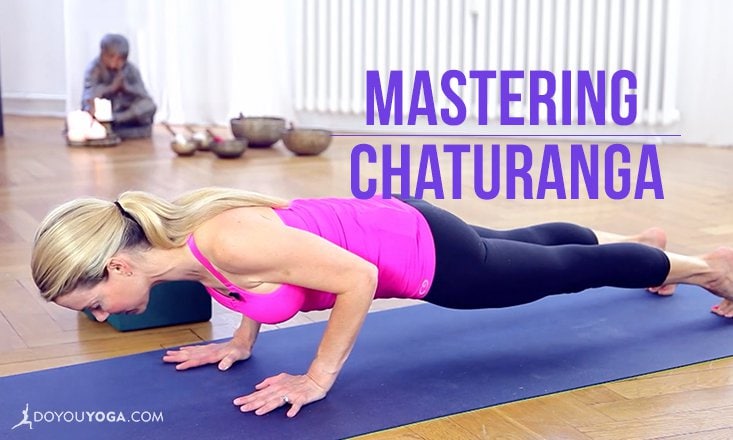Chaturanga Dandasana is a yoga pose that can take you seamlessly from pose to pose during your practice — like a gentle wave that provides balance and flow.
But for some it can seem like an impossible, uncomfortable hurdle. What is it about Chaturanga that is so difficult, and why is mastering Chaturanga important for anatomical alignment and asana practice?
As you flow from Downward Dog into Chaturanga, much of your weight shifts into your shoulders, and this is one of the reasons it can be so difficult. It’s also one of the reasons that this pose can initially be more difficult for women than for men.
Chaturanga also heavily engages the triceps, chest and core, and many people just starting out with this pose say that it feels very awkward in the elbow joint. Learning and practicing this pose incorrectly can lead to strain, and even injury, in the shoulders, elbows and beyond, so it is essential that everyone practices this pose with safe and proper form.
Chaturanga Up Close: Tips and Modifications
The first thing to note is that Chaturanga is not a traditional pushup. Instead of letting your elbows wing out to the sides, Chaturanga requires that you keep your elbows tucked in beside your ribs. As you move through Chaturanga, you should be able to feel your elbows brushing the sides of your torso.
This is very challenging for the triceps and the core, so those who are still building their strength in these parts of the body may want to practice this pose with their knees resting on the mat, shortening the lever of the body and putting less weight into these muscle groups.
This is a great way to build up to a safe, effective Chaturanga. You can also use a strap (wrapped around your lower arms) to help you make sure that your elbows are correctly aligned.
Place the strap around your forearms just below your elbows and tighten it until the strap stays on when you are in Plank pose. The strap will serve as a reminder to think about where your elbows are in space and in relation to your body during this pose.
Building up to Chaturanga using modifications and props is essential to gain the ability to use this pose to strengthen your shoulders. If your triceps and core aren’t prepped for the work required in this posture, your body will start to recruit and engage your chest more than it should.
This can cause — as anatomist Kreg Weiss puts it — “…winging of the shoulder blades, and a cascading destabilization; all of which can lead to injury in the musculature supporting the shoulder girdle.” So, prepping your body properly for Chaturanga is very important for its safety.
Where do the shoulder benefits come in?
Your shoulders only really start to engage in this pose once you’ve built up enough strength and stabilized in the proper alignment to feel comfortable and supported. Then your shoulders start to work in valuable ways.
The workout that your shoulders get in Chaturanga is one that prepares them for even more advanced poses, particularly arm balances and some inversions.
Flowing from Chaturanga into Upward Facing Dog, as you do in a Vinyasa flow, also helps your muscles in this area move more fluidly and with more coordination, improving range of motion. Once you’ve mastered Chaturanga, your body will be ready to work toward other exciting poses with increased strength and mobility.
Your improved shoulder girdle strength will help with good posture as well, leading to a host of other benefits throughout your body.
On a more anatomic level, it’s important to remember that your shoulder girdle—three bones and many long, thin connective tissues—is the central conjoining area for your upper body. Many of the muscles in your arms, wrists and hands, connect to your body through the sternoclavicular joint, an essential part of your shoulder girdle.
As author, yoga and anatomy teacher Jennilee Toner says, “The 32 bones that extend outward from your chest, and often offer expression of what is happening in your heart, only attach to your axial skeleton with one small joint. The only way all those 32 bones stay on the torso is with soft connective tissues; a systematic placement of various muscles, tendons and ligaments. It is a marvelous wonder to behold”.
So take care of your shoulders; strengthen them and stretch them with correct form in yoga poses, and Chaturanga your way to an even better yoga practice.


